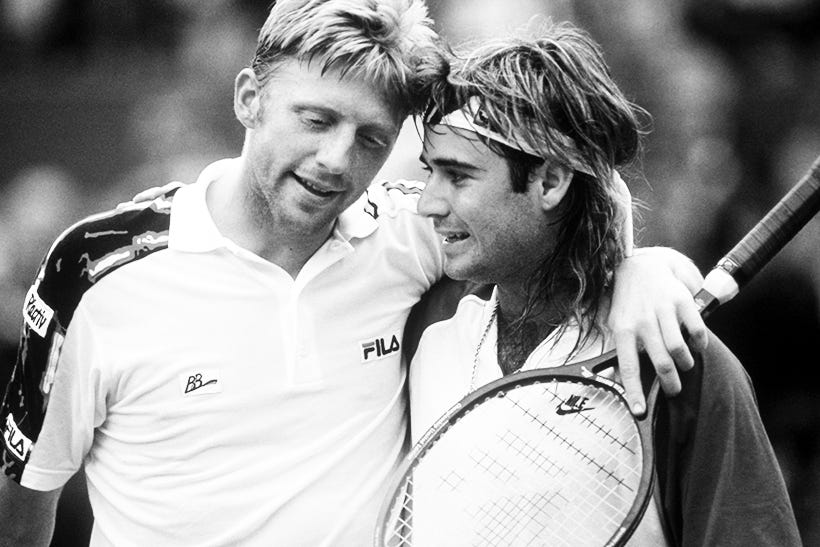How strategic analysis can change the game for brands (and tennis)
In the history of tennis, few rivalries are as legendary as that of André Agassi and Boris Becker.
In the history of tennis, few rivalries are as legendary as that of André Agassi and Boris Becker. One of their most intense encounters took place during the 1995 US Open semifinals, when Becker surprised everyone by blowing kisses to Agassi’s then-girlfriend, Brooke Shields, from the court. This unexpected gesture raised the tension between the two players, marking a high point in their rivalry.
Despite losing their previous three matches, Agassi decided it was time to turn things around. Driven by a desire to find an advantage, he spent hours analyzing tapes of Becker’s games, looking for any weakness he could exploit. Eventually, he uncovered a crucial pattern: every time Becker served, the position of his tongue seemed to reveal the direction of his shot. If Becker kept his tongue centered in his mouth, the serve would go down the middle; if he shifted it to one side, the serve was likely headed wide. This discovery became the cornerstone of Agassi’s strategy to defeat his talented opponent.
Years later, when both had retired from professional tennis, Agassi finally shared his secret with Becker during a chance meeting at Oktoberfest. Amid beers and laughter, Agassi confessed that this tiny detail had been the key to his victories. Becker, astonished, shook his head and said, "It’s unreal. After every loss, I’d go home and tell my wife, ‘It’s like he can read my mind every time I serve.’” The two rivals-turned-friends laughed, realizing how this subtle observation had shaped their legendary battles on the court.
This story highlights the power of a thorough analysis like SWOT (Strengths, Weaknesses, Opportunities, Threats). Just as Agassi detected a "weakness" in Becker’s game and turned it into a strategic "opportunity," a SWOT analysis allows companies or individuals to deeply examine their strengths, vulnerabilities, potential opportunities, and external threats. By understanding these factors, just as Agassi did with Becker, one can develop sharper, more effective strategies that leverage every possible advantage to stay competitive. Agassi and Becker’s story isn’t just a memorable moment in sports history; it’s also a reminder that well-executed strategic analysis can be the key to success.
The Red Bull "bin" stunt in London: A lesson in guerrilla marketing
Red Bull, known for its bold and unconventional marketing, pulled off a memorable stunt in London that exemplified its edgy approach to brand promotion. In the early 2000s, Red Bull set out to make a splash in a city already saturated with advertisements and high-profile brands. They needed a way to catch people’s attention without a massive budget or traditional ads. The solution? They took to the streets with a quirky twist.
Red Bull team members went around London and began placing crushed cans of Red Bull in the tops of public trash bins around the city. But these cans weren’t just casually tossed in—each one was carefully wedged to look as if it had been hastily thrown away after a quick energy boost, like a forgotten piece of evidence that someone had just "grabbed some wings" and moved on with their day.
The strategy was simple but effective. As people walked past these bins, they’d see crushed Red Bull cans everywhere they went, even in unexpected places. It created the illusion that Red Bull was everywhere—that people were drinking it constantly, with evidence "left behind" throughout the city. The branding was subtle but impactful, giving Red Bull a presence without using traditional advertising space.
This guerrilla marketing tactic was a powerful way to position Red Bull as a brand for people on the go, appealing to those who needed a quick energy boost in their busy, urban lives. The stunt showcased Red Bull’s creativity in capturing public attention and their understanding of urban culture.
The "bins" stunt is now remembered as a smart example of how brands can break through the noise with a little ingenuity. Like a well-executed SWOT analysis, this approach took advantage of a specific environment (the urban hustle of London) and tapped into Red Bull’s strengths—its edgy image and appeal to young, busy professionals. By identifying an opportunity in a crowded market and using an unconventional tactic, Red Bull managed to turn a simple act into an unforgettable brand statement.
From the physical shelf to the virtual: Strategies to stand out online through the digital shelf (in spanish):
How to get more traffic to your store
Change happens when the pain of staying is greater than the pain of change.
— Tony Robbins




